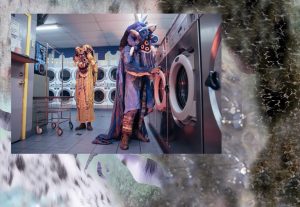13th Shanghai Biennale
Bodies of Water
April 17–July 25, 2021
Digital press preview event: April 15, 9–10pm, CST; An online introduction to the Biennale by PSA Director Gong Yan, Chief Curator Andrés Jaque and the curatorial team.
Chief Curator: Andrés Jaque
Curators: Marina Otero Verzier, Lucia Pietroiusti, You Mi
Head of Research and Publications: Filipa Ramos
“The flow and flush of waters sustain our own bodies, but also connect them to other bodies, to other worlds beyond our human selves.”
—Astrida Neimanis
The Power Station of Art (PSA) is delighted to announce the culmination of the 13th Shanghai Biennale, Bodies of Water. Its main exhibition PHASE 03: AN EXHIBITION opens on April 17, 2021, with 64 participating artists presenting projects, including 33 new commissions, at the PSA and other venues across Shanghai.
To challenge the traditional biennale format and explore the participant-public divide, the Biennale is unfolding over the course of nine months as an in crescendo project. It began in November 2020 with PHASE 01: *A* WET-RUN REHEARSAL, a five-day inaugural program, and was followed by PHASE 02: AN ECOSYSTEM OF ALLIANCES, five months of activity and programing. This allowed the artists, thinkers and curators involved in the Biennale to develop their work in close collaboration with the City of Shanghai, its people, networks of activism, organizations, and institutions.
From bodies to other bodies, climates, ecosystems and technologies, all life forms are inextricably interconnected and interdependent. Bodies of Water asks us to examine this living collectivity at a time when the earth is facing unprecedented challenges, from the accelerating climate crisis to the current global pandemic. The participating artists and collectives present artworks that explore caring-based approaches which negotiate our entanglement in extended ecosystems of interdependency. A significant number of these works, 33 in total, have been specifically commissioned and conceived for the space and times of the Biennale.
Participating artists:
Alberto Baraya; Ana Mendieta; Antoni Muntadas*; Astrida Neimanis*; Aunty Rhonda Dixon-Grovenor; Clare Britton*; Ayesha Tan Jones*; Cao Minghao and Chen Jianjun*; Carlos Casas*; Carlos Irijalba*; Cecilia Vicuña; Cheng Xinyi; Cooking Sections (Daniel Fernández Pascual and Alon Schwabe); Dai Chenlian*; Debajo del Sombrero (participating artists: Andrés Fernández, José Manuel Egea, Miguel García, María Lapastora and Belén Sánchez); Diakron and Emil Rønn Andersen*; Diane Severin Nguyen*; Feliciano Centurión; Guo Fengyi; Heather Phillipson*; Ibiye Camp*; Itziar Okariz*; Jenna Sutela; Joan Jonas*; Karrabing Film Collective; Kyriaki Goni*; Liam Young; Michael Wang*; Nerea Calvillo (C+arquitectas)*; P Staff in collaboration with Basse Stittgen*; Pepe Espaliú; Pu Yingwei*; ReUnion X DMAS*; Revital Cohen and Tuur Van Balen; Sun Xiaoxing, Qiu Zhen, Zhao Kunfang and Huang Siyao*; Tabita Rézaire; Torkwase Dyson*; Vera Frenkel; WORKac (Amale Andraos and Daniel Edward Wood); Zadie Xa and Benito Mayor Vallejo*; Zheng Mahler (Royce Ng and Daisy Bisenieks)
*Names with asterisks correspond to new commissions. Further artists to be announced at the press preview on April 15, 2021.
Bodies of Water, the exhibition, will be in dialogue with the history and geography of Shanghai, both a testament to our transspecies collectivity. It will unravel across the city, beginning at the PSA, a former coal-electric plant that fueled the industrialization of the Huangpu River, a cauldron of accelerated production and bodily mobilization. Beyond the PSA, the exhibition will expand to other important locations: the Sunke Villa at the Columbia Circle—one of the historical remnants of Shanghai’s colonial control of the environment, created from the drying of its original wetland ecosystem—and the former building of the Commercial Printing Factory—a publishing house where the school books used to unify knowledge across the country were printed.
The theme of the Biennale is intimately connected to Shanghai and the 5,000-meter descent of the East China Sea of Qinghai-Tibet Plateau’s meltwaters, located at the intersection of the Huangpu and the Yangtze Rivers, and in the vicinity of the human-made Jing-Hang Grand Canal. Particles dragged from up to 6,300 kilometers of sediment are metabolized by edible plants at the Yangtze Delta, China’s most fertile agricultural site. Mineral and organic matter, travelling suspended as bodies of water, is then rebodied, the flow of water reconstructing geographies and vitalizing organisms.
Chief Curator Andrés Jaque says: “The 13th Shanghai Biennale advocates for the momentous contribution that art plays in the reconstruction of a world shaped by environmental, social and political distress. The Biennale is sensitive to the way art constitutes and infiltrates life itself, and to its capacities for bodied reparation, transformation and dissidence”.
The Biennale has been unfolding since November 2020 in an in crescendo model, opening with PHASE 01: *A* WET-RUN REHEARSAL (November 10–14, 2020), a week-long summit in the form of a performative assembly in which contributors could present their work at the PSA and in a network of art spaces along the Yangtze River. PHASE 02: AN ECOSYSTEM OF ALLIANCES followed (November 15, 2020–April 16, 2021), a period of heightened activity in the run up to the main exhibition in which, acknowledging art’s interdependency with science, social constructs, technology, and modes of spirituality, the Biennale forged alliances with the historical School of Philosophy of the Fudan University, the Shanghai Institute of Visual Arts, and with the students and faculty of 5 art schools in the city. Since its launch, it has also expanded through the networks of screens of the Shanghai Subway and through its online platform, with special episodes co-produced by Docu-TV and broadcast to the world through the Dragon TV Network and its Bilibili social networks. Overall, the biennale aims to challenge the contributor/public divide to understand the biennale as an “ecosystem of alliances,” installed in the infrastructures where life happens, and considering artists and audiences as co participants in processes of reconstruction.


